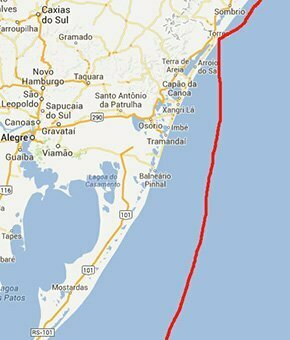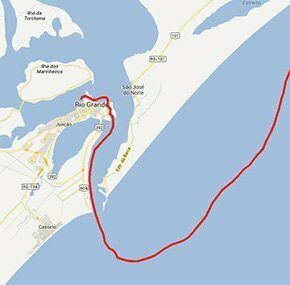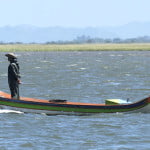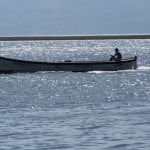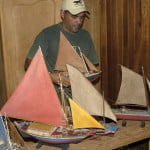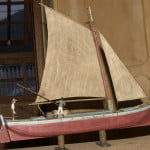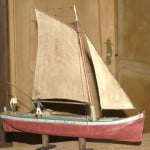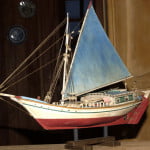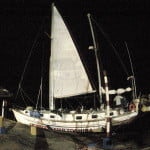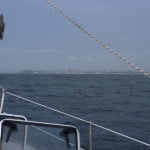Wednesday, 07 – 03 – 2007.
That’s it: we arrived at the end. It’s 8.30 p.m. We have been sailing on Rio Grande do Sul’s coast for three hours, the last coastal state out of seventeen, if you come from the North. For almost two years, we have been in pursuit of the goal we are about to achieve now.
We left Laguna very early. Alonso turned the motor on at 4 a.m. He put the mainsail up and then we lifted anchor.
Santo Antonio lagoon was dark when we left towards the sea wall obstructed on the south side by a rock where waves break. This occurred inside the area that should be protected. It is frightening.
However, on the north side, depth is never below 4 meters and most of the way is above it.
When we passed Santa Marta lighthouse, in open sea, I called the operator by radio, sergeant Jacinto, a regular TV viewer who looked for us when we were shooting scenes for last trip’s program. We arranged a talk on the VHF at departure time. That’s what I did today. I told him what our sailing plan was as well as the possible arrival time.
At 5 p.m. we passed Torres, a district at Santa Catarina’s border, which is the beginning of Rio Grande do Sul’s coast. We shot images of Lobos Island. A tiny little island which is rather a group of rocks. Anyway, it is the only coastal « island » of this state. It is also famous because between July and November sea lions come up along the coast and mate here.
Right now, we are approaching Tramandai. We still have to sail 180 miles to reach the next safe port, Rio Grande.
Today, we have sailed with the motor most of the time; although the mainsail and the mizzen sail have been up since we left. Wind had gone. But half an hour ago the northeast wind started to blow again. Suddenly, it started to blow between 15 and 19 knots. Excellent. The genoa was opened and now we are sailing at 7.5, 8 knots. It is better. The faster we go, the better. Joselia Pegorim has foreseen a strong cold front on Friday.
Even when you sail in the dark, you can see signs of occupation on this part of the coast. It is 38 miles or 70 kilometers from Torres to Tramandai; all the way long you can see light on the coast showing dense occupation. One city next to the other. It is like this until you see the reef separating Patos Lagoon, 25 miles southwards, in Quintao, making up a total of 66 continuous miles or 122 kilometers of cities. That’s a lot of people of all kinds with different interests occupying the same coast. Conflicts in regard to its use, lack of interest from those who come here, cunning legislation full of stages, uncertain inspection; all this costs a lot.
Now, near the end, when I think of this scenery I can’t avoid a couple of conclusions. They are not the only ones for our huge and complex coast, but a summary of what I have seen and learned during this long journey.
There are three protagonists: the sea, the coast and the people. I’m going to start with the first and let me warn you, it is difficult not to repeat the cliché. “The seas of the planet are sick” – here they are – and they need help.
Ignorance in some cases, greed or selfishness in others; we are destroying one of the most important ecosystems of the planet. Mostly responsible for the climate of the Earth, it also gives us proteins, mineral richness, leisure, sports, and its beauty encourages tourism. The sea is also fundamental as source of energy and foreign business purposes. Without thousands of maritime organisms, there would be a decrease of 40% in regard to the biodiversity of the planet. According to the book Amazonia Azul (Blue Amazon), “it contains 96% of the planet’s fresh water, 86% of the total evaporation is supplied by the sea and it receives 78% of all the precipitation.” Even the air we breathe depends significantly on the photosynthesis provided by the phytoplankton’ algae (80% of the oxygen of the atmosphere). Consequently, the sea contributes to remove carbon dioxide which causes the greenhouse effect in the atmosphere.
It was this huge and fascinating organism that for the first time created life in this planet. This happened 3.5 billion years ago when single-cell beings, tiny creatures covered by fragile membranes appeared. They reigned for 2.5 billion years. Currently, the scientific thesis which is more often studied and believed to be true due to technological progress suggests that somehow these cells developed mechanisms which made them act together and form the first animal on Earth.
Since Charles Darwin published, in 1859, the Origin of Species (The title of the first edition sold out on one single day was “The Origin of Species by means of Natural Selection or the Preservation of Favored Races in the Struggle for Life” ) thousands of experts have tried to decipher this enigma which was eventually explained in the eighties by evolution biologist Mitchel Sogin from the Laboratory of Maritime Biology, Woods Hole, in Cape Cod, in the United States. Sogin obtained and mapped the genetic code of the sponges, this primitive aquatic animal (which lives in seas and rivers), and then compared with that of other structures and proved that it is at the origin of the entire animal kingdom.
“The sponges are the first pluricell animal and their genetic matrix is the winner, all the other animals are based on this same matrix”, stated the scientist (source: The Shape of Life, National Geographic Society).
They are present in all the seas: from polar to tropical areas. When we dove in Fernando de Noronha and Abrolhos, we saw a couple of beautiful and exotic sponges. They are filtering animals which pump water to extract food from it. 500 million years ago, they were also pioneers of the asexual reproduction.
In spite of that the ecosystem hasn’t been spared by men.
It is threatened daily on a planetary basis. You should know that waste thrown without being treated is the greatest source of pollution in the whole world. The second source is industrial pollution and finally, there are other such as toxic pollution, caused by pesticides and herbicides used in agriculture, cars, mining, deforestation, etc. According to the United Nations, today there are 150 dead zones in the sea without oxygen necessary for life. The sea has been treated as man’s waste depository since ancient times. Today, since we have an increasing population, seven billion people is the estimated world population for 2010 (UN) and two thirds on the coast, the sea cannot stand that any more. Its regenerative capacity is over. Brazil has one of the largest coastal zones, therefore it should play a fundamental role, but it doesn’t. Most coastal cities throw untreated waste into the sea. When the urban population goes to the beach, it gets dirtier. Every day ships bring exotic organisms which replace native species. An increasing number of companies are established on the coast and they are not always socially and environmentally responsible.
Summing all this up, the result couldn’t be different. Scientists have also found out that more than 80% of the ocean pollution is caused by human activities whose origin is in the continents. Only the slightest part (sea pollution) results from eminently maritime activities such as ships’ and boats’ traffic or oil exploitation.
Apparently these things have nothing to do with sea pollution, in fact they do. The responsibility, like it or not, is collective and in our hands.
Start thinking about these concepts. I will continue tomorrow.
Thursday, 08 – 03 – 2007.
Today we had a marvelous sailing day. The northeast wind blew most of the time at 20 knots allowing us to surf several times on waves at 10 knots.
It was a wonderful sail. All of us had good time at the rudder of the boat, even Cardozo. The Endless Sea was wild, “nervous”, as usual when there is this type of strong wind on the stern or three quarters of it. Nevertheless, our film maker who focused on his task controlled it quite well.
At the end of the day, when we were approaching Rio Grande, we got a VHF call from the patrol boat, Beneventes, from the Navy of Brazil which was sailing around. We were asked about our destination, arrival time and were warned about “a cold front with a strength between 6 and 7 (between 22 and 33 knots), expected at the end of the afternoon.”
Jesus Christ! It was the same cold forecasted by Joselia. The only difference was that our meteorologist had predicted its arrival on Friday’s early morning, whereas people from the Navy predicted it for this afternoon.
The only thing we could do was to sail the best we possibly could to arrive as soon as possible. We just looked at the lightening horizon hoping to be spared. The infinite was covered by lightning falling uninterruptedly.
At 10:10 p.m. we entered by the sea wall of Rio Grande port. I warned Beneventes. A few minutes later the storm arrived.
In a few seconds the wind reached 45 knots according to the clock on board. Nothing could be seen on the prow.
Instead of looking for the Yacht Club with wind blowing strongly, I decided to put the boat against the wind and to accelerate fast enough to keep it still. We were beside the first pier, there was enough light to guide us. That’s where we stayed until it was over. Half an hour later it calmed down and then we looked for shelter in the back of the port where we dropped the anchor and slept. I was grateful for having arrived before the front. How nice to be in a port when such a storm falls over you.
Friday, 09 – 03 – 2007.
Now I will continue what I had just started when we were sailing: an overall view about the actors that play a role in the oceans here and in the world. Today, I will make brief comments on the occupation of our coast since the biggest or the smallest threat in regard to our oceans depends on it.
I learned a couple of things. First, a problem has not a single diagnosis. Secondly, I’m sure we have to change rapidly our action and policies, if we don’t want to be partially blamed for one more disaster.
Ports and environmental consequences (but also economic and social benefits), I was already aware of them as well as what results from cities and companies on the coast. The amount of people who live and go to the coast, that’s not new either.
What I probably wasn’t aware of was the result of these problems altogether. The level of pollution, even in the state of Amapa which is not densely occupied, astonished me. Amapa’s rivers have been constantly devastated by the population’s waste starting with the district of Oiapoque and its hilarious plaques on the pollution of the river. There is also mercury in other rivers where gold is extracted.
In the state of Para the situation is the same in regard to the absolute lack of basic sanitation. However, in Belem, there are also very risky port activities which transport huge amounts of oil and other more toxic substances in barges without any contention or blockage measures to fight against or mitigate in case of accidents.
When you enter in the Northeast, there is also the spree of crustacean culture which devastates huge mangrove areas (in addition to areas of coconut trees and babassu palm trees) one of the most important breeding places of maritime life.
There is one more devastating ingredient: real estate speculation at an international level.
Strong, abundant European money builds resorts one after another (there are also Brazilian condominiums and buildings). The vast majority devastates the landscape, making trivial what took nature a few eras to make, offering little employment and little increase of the economic activity of local communities.
Cities grow and migratory cycles occur very often. However, the public administration is not well prepared even when there is no corruption; many times disobeying laws deliberately and allowing occupation when the federal administration or even IBAMA are the agents in charge of doing so. Therefore, mangroves are filled with earth. And authorities allow the occupation regardless of the necessary rules; what really counts is rapid funds for today’s weak public coffers. Tomorrow we’ll see what happens.
Next generations will have to handle with the situation, if it is true there will be something left. This happens not only with mangroves, but also with other sensitive and important ecosystems such as dunes, beaches, crags, reefs, etc.
Speculators act under the administration’s nose and legislation doesn’t help. The blame is always put on someone else. Those who are in charge don’t agree; meanwhile crime remains unpunished.
The same thing happens with Ibama which has no funds to carry out one of its tasks, that is inspection. They haven’t even boats!
Meanwhile the coast is devastated. Irregular buildings are found everywhere on the east coast of Ceara. The only intact area left is part of the west coast of the state.
In Rio Grande do Norte, there are schizophrenic beaches such as the famous Pipa, densely occupied with a chaotic organization. Some grow behind dune areas, like in Buzios, and you also see for sale plaques in English on the roads.
This devastation is often found in the Northeast, except in Paraiba. Additionally, there are states where the coast’s conservation units are abandoned, such as Alagoas.
In Pernambuco, the result was worse. It is proved that one of the reasons of shark attacks on Pernambuco’s beaches is the devastation of Suape’s mangroves as well as the fact of having filled them with earth.
One more problem commonly found in the Northeast, including in Paraiba, involves inhabitants and tourists constantly walking on coral structures (the most important maritime ecosystem which is already threatened by climatic changes) near the coast.
Usually, most rivers in Brazil which flow into the coast are polluted, obstructed, with barrages, with no ciliary forest and buildings too near the mouth.
Nevertheless, the federal government insists on shifting the Sao Francisco River (the public notice of the first part of the project was published this month) at a cost of 6.5 billion reais whereas last year MMA total budget didn’t reach 500 million reais including costs and investments.
There is also one more guest in this plot: erosion. Since these things are mostly accepted, sometimes prompted by public authorities, erosion is present in practically 40% of Brazil’s coast today.
In Bahia, the government supports huge shrimp farms and it fosters tilapia breeding, an aggressive exotic species of fresh water in the middle of the estuary, like in the Cairu River!
Before finishing the issue on the Northeast, in the south part pine and eucalyptus reforestation (both exotic) has increasingly covered the area where there was the richest Atlantic forest.
In the Southeast, especially in the state of Espirito Santo, reforestation covers the entire coast. On any beach, if you look on both sides or behind, you will see a reforestation area (I submitted myself to this test).
And then comes Rio de Janeiro where you see the Redeemer Christ and the bay of Guanabara which is dead, completely rotten. Slums keep on climbing up the hills.
The situation is a little bit better in Sao Paulo, regardless the dead estuary of Santos and the devastation of Guaruja’s landscape. Cubatao was recovered and in the south of the state, from Jureia to Parana’s border, in Cananeia, there is a series of conservation units, the best picture we have seen on Brazil’s coast.
But then it gets worse. The bay of Paranagua is heavily contaminated by toxic metals, in addition to other polluting agents.
Santa Catarina made a bad impression on me. Its most famous beaches are surrounded by walls. From one end to the other. A resonant successful example of real estate speculation of the last 15, 20 years. Basic sanitation, especially on these beaches, but not only, is ridiculous, if there is barely any.
Since the south coast of Rio Grande do Sul has inhospitable areas and difficult access, their original landscape has been preserved. However, in the north, conurbation is a fact. From Torres to Tramandai. Neither one nor the other are free from human pollution, pine and eucalyptus reforestation hasn’t spared them either (fostered from 1970 to 1980) on the coastal plain. From Torres to the end of the reef which separates Patos Lagoon from the sea, reforestation occurred in dune areas. Consequently, flooded areas behind had to be drained!
This disastrous action caused two serious implications. The vegetation which fixed frontal dunes on the coast of the state died without water. When the northeast wind blows the sand is thrown towards the interior. At the same time, countless animals, especially mammals, amphibians and reptiles which lived in humid areas decreased dramatically.
The last thing is the fact that public opinion has shown very little interest so far in regard to the sea or the coastal zone; the only things that matter are beach and leisure. According to Professor Lauro Barcelos, FURG’s oceanographer, “Brazilian people know nothing about the sea. They love the beach, but they can’t see what is beyond the breaking waves.” Thus they don’t react; or they react very little against predatory occupation that devastates the landscape which made us known all over the world. They also destroy what remains from maritime life since that’s where most food chain starts.
It is impossible not to worry.
Saturday, 10 – 03 – 2007.
Since there was good weather, the two last days we recorded images of this port city and the neighboring area for the three programs we will make. One will be on the north coast, the other on the reef of Patos Lagoon and the third on Rio Grande.
We focused on the port and its huge sea wall, sail cars which go around them on rails, traditional boats, fishing boats, and the old remaining settlement.
Previously, I have made comments on aspects of the sea and the coast; today, I’ll talk about the inhabitants, those who work, study or come to this special area. This is a very rich and enthusiastic subject. Many points of view are possible. I’ll express my humble opinion hoping to contribute. I don’t want to have a neglectful attitude.
On the strip called Coastal Zone are found 400 out of Brazil’s five thousand districts. The average occupation on the coast is 87 inhabitants per square meter, whereas the national average is 17 inhabitants per square meter.
Since the Coastal Zone is environmentally speaking very important, it is acknowledged by the Constitution as Brazilian Environmental Patrimony and “its occupation shall happen in a self-sustainable way”.
Here is the great challenge. There is a more complex task which is to take into account income, social, cultural and occupational differences.
There is not only the fact that 15 out of Brazil’s 26 metropolitan areas are on the coast (IBGE), in the last years the areas which are less densely occupied have become an important target for tourism, urbanization and industrialization.
In these areas you find the abandoned and lost indigenous population; groups comprehending non industrial fishermen, quilombolas (run-away slaves), indigenous tribes as well as other people who live from extraction of several ecosystems present in this transition area between the sea and the continent.
I have mentioned on this journey different threats which have devastated this natural richness; however, the most impressive aspect is the chaotic legislation which permits permanent conflicts among the different stages of power, that is: districts, states and the Union.
Pass the bucket game, that’s what I found; a type of national sport in addition to football. But not only this; there is also pure ignorance at the district administration level.
However, the main problem is garbage collection and the lack of basic sanitation.
According to IBGE (2000), 60% of the population has no waste system and only 20% of the country’s waste is treated (IBGE’s Sanitation Atlas).
Precise data show that only 47.2% of all the Brazilian homes have waste system.
Garbage collection is not that bad, although studies show that 63.3% of the districts have open air garbage deposits without any type of treatment.
Don’t forget it rains a lot in this tropical country. Well, these rains also fall on these open air garbage deposits. Where do you think this mortal soup goes to?
The combination of these two factors, shows IBGE, were responsible in 2000 for 800 thousand cases of diseases such as dengue, malaria, A type hepatitis, leptospirosis, typhus and yellow fever.
During this period, more than three thousand children (below the age of 5) died of diarrhea! This is due to the bad quality of water, lack of garbage and waste treatment as well as high levels of pollution in our seas.
Tourists and summer visitors also contribute. Every holiday thousands of people leave urban centers and go to the beaches. Most of them throw everything you can imagine on the sand or in the sea. From cigarette butts to plastic bottles; their cars also deposit through the exhaust-pipe more oil in the sea.
It’s nobody’s fault but ours.
In general these data are not new. There are two important findings. Number one, from the sea the view is cruel, it shows you the real dimension of the devastation, it is astonishing. Even someone like me who is used to sailing is astonished. Number two and the worst: the Brazilian citizen has neglected the sea. Without the pressure of the public opinion there is no hope.
I will finish this tomorrow. It is very late.
Sunday, 11 – 03 – 2007.
This morning we shot the shrimp fishing by indigenous people in Patos Lagoon.
The nets were less than a hundred meters far from huge fetid waste ducts thrown in natura in the lagoon (Ave. Henrique Pancada, in front of Marinheiros Island). And then we went to Porto Alegre by car. We had to pick up Paulina Chamorro who was arriving from Sao Paulo as well as the Land Rover we had rented to go along the coast of this state.
It is not possible to approach Rio Grande do Sul’s coast by boat. It is straight, low and heavy winds blow most of the time. If we want to show it on TV, we must come closer.
We arrived in Torres late.
Monday, 12 – 03 – 2007.
How and since when has the Brazilian citizen neglected the sea?
This is one more difficult question to answer. I accept to take the risk but we have to go back to the past and have a look at the situation in Brazil during the 19th and 20th centuries.
In 1865, Paraguay invaded the south of Mato Grosso.
Only a month and a half later, federal authorities were aware of the situation in Rio de Janeiro. The interior and its population were very away from the official Brazil which up to that moment was on the coast.
Access was difficult and means of communication were little effective.
As soon as the republic was proclaimed, the country’s first coordinate action to incorporate lands and populations took place. Marshal Candido Mariano Rondon was chosen to carry out this task. His mission was to build bridges and telegraph lines between Cuiaba and Corumba encouraged either by people from the army who were worried or the rubber exploration spree. This occurred between 1900 and 1906.
In 1907, Afonso Pena was the President of the Republic and asked Rondon to carry out a more complicated task: to build a new line in the north and west entering in the Amazon basin. The Rondon Committee was born. In addition to the telegraph, Marshal Rondon had to explore the area and promote the national integration (data from the book Rondon, by Todd A. Diacon)
The need of moving the capital from the coast to the interior was already an issue at that time for security reasons.
However nothing was done.
Eventually, after the Second World War, the official impulse of this step started again.
Up to that moment, approximately 40 million Brazilian lived on the coast.
Then the government created the Roncador-Xingu expedition whose goal was among other things to open up the “unknown land”. Simultaneously, the Central Brazil Foundation was created to settle habitation centers in places chosen by the expedition.
This is the mission which made the Villas Boas brothers known. One of the several legacies was the foundation of 42 cities and villages having over a thousand inhabitants (data from the book March to the West – The Roncador-Xingu Expedition Epopee).
The third phase occurred in the 50’s, when Juscelino K. came into power and turned the change of the capital into reality. From Rio, on the coast, to the meadow in the center of Brazil. Brasilia was born.
The forth and last one also took place during Juscelino’s administration when he fostered industrialization by the establishment of the car industry. And then our development model put emphasis on road transportation.
From then on, this country whose “birth had the sea as placenta and navigation as umbilical cord at the core of the national identity” (according to Dennis Radünz in his book Sea National Museum – Brazilian Boats), has neglected the sea.
Of course, this is a brief summary. However, I’m sure that from that moment on we started to neglect the coast. We forgot our tradition, natural cycles and fragility. This area which had been preserved relatively intact since 1500 due to its huge extension, in less than 50 years, an instant when we talk about a nation’s History, was turned into the images we have been showing.
It is devastating to notice how much we damaged in this short period of time. If we don’t do anything about, a tremendously heavy burden will be put on this generation’s shoulder by the future ones.
This morning we left Torres at the border between Rio Grande do Sul and Santa Catarina and drove to the district of Mostardas at the beginning of the reef of Patos Lagoon.
We checked this part of Rio Grande do Sul’s coast visiting Arroio do Sal, Capão Novo, Xangri-la, Imbe, Tramandai and Quintão. Every beach, every kilometer.
In general, the data on the waste system follow the same sad tendency. The best situation is that of Torres with 40% and the worst is Tramandai with only 14%.
The landscape is similar. The coastal plain which was an area of lagoons and reefs is covered either by Pinus Elliots reforestation or rice culture.
On the beaches, except Torres, frontal dunes are found.
Tomorrow we will visit Peixe Lagoon.
Tuesday, 13 – 03 – 2007.
Today we have visited Peixe Lagoon’s National Park with one of the most beautiful landscapes we have seen on the Brazilian coast. The lagoon is at the reef which has on one side Patos Lagoon and on the other the ocean. It is 35 kilometers long and 2 kilometers wide, its average depth is 60 centimeters, but in the bar (which opens and closes depending on the winds) it may reach 2 meters. The area is a cradle for pink shrimp, mullet and sole.
The vegetation is basically formed by reefs, swamps, fields of dunes, fresh and brackish water lagoons and beaches. It is a 35 km long beach and if you’re lucky you can find maritime lions, penguins, porpoises, white whales and different types of turtles.
We left Mostardas early followed by Rodrigo Meneses, park expert, and Fabiano Souza who guided us during our visit. The entire area of the lagoon and the neighboring areas are one of the most important refuges of migratory birds of the north and south hemispheres.
Thousands of curlews come from Alaska, different species, on a journey of 15 thousand kilometers.
Pink flamingoes come from Argentina and Chile. But there are many more: hawks, different types of kingfishers, colhereiros, teals, sea gulls and noddies, black neck swans, sandpipers, herons; well, a countless number of them, it is wonderful. About 190 species were classified.
Historically, this is an area of low demographic density due to difficult access and hard weather, which assured a “certain” integrity. I had to use quotation marks because there are problems such as Pinus reforestation and pasture for cattle. I asked the guide why. Discouraging answer: the park was founded in 1986, after TWENTY YEARS, only 6% of the old landowners were paid by the government. Consequently, those who got nothing have the right to continue their activities in spite of being extremely harmful like the ones we have mentioned.
Visiting it was a pleasant surprise anyway. The extraordinary explosion of life, the colors and the landscape are wonderful.
Wednesday, 14 – 03 – 2007.
We left Mostardas and went northwards to São José do Norte, where we were going to take the barge to Rio Grande. But when we arrived, the last one had already left.
We had to spend the night there. The hotel structure is not good enough. There were only two, if it is true we can call that a hotel. There weren’t enough rooms.
Paulina and Cardozo slept in one and Sven Jansen (the Land Rover man) and I slept in the other.
Thursday, 15 – 03 – 2007.
We crossed the canal and went straight away to Furg, Rio Grande University Foundation. We interviewed two remarkable experts: Ulrich Seeliger, professor of the Oceanography Department, who wrote many books and papers on the coastal zone, and Lauro Barcellos, oceanographer and museologist.
Here is a brief summary: they are concerned about pine and eucalyptus reforestation, resulting from federal incentives in the 70’s, especially worried about the drainage of the areas behind the dunes and the natural proliferation of trees.
Professor Ulrich said that on Rio Grande do Sul’s coast, except the area of Torres, there are no rocks. 622 kilometers of coast formed essentially by sand.
Both mentioned the increasing activity of industrial fishing, especially trawl-net fishing. They explained to us that here the consequence is even worse. Rio Grande’s sea is quite low on the coast and many fishes hide from their predators in the low part, constantly swept by the nets.
Lauro said that it is difficult to set fishing rules; ironically he talked about the “man’s duty of exterminating life in the oceans”. He concluded: “we keep on extracting until final exhaustion”.
Both mentioned the decreasing maritime and animal life on the coastal zone. “Today’s figures are significantly smaller compared to the 50’s”, said Lauro.
Professor Ulrich complained about the government: “when they want to know about the impacts on the coast, most of the time NGOs are asked to give this information, instead of researchers from the university”.
Professor Lauro concluded: “The human being is the greatest hope, the greatest threat too.”
Friday, 16 – 03 – 2007.
We went to Chui by car and I’ll make comments in the next logbook.
Saturday, 17 – 03 – 2007.
We returned and slept in the Endless Sea in Rio Grande.
Sunday, 18 – 03 – 2007.
We took the car again and went to Porto Alegre and then to Sao Paulo.
Alonso is in charge of taking Marzão to the capital as soon as the weather gets better. Copious rain and strong winds refrain it from leaving now.
On our next and last trip we will record the three last programs.


